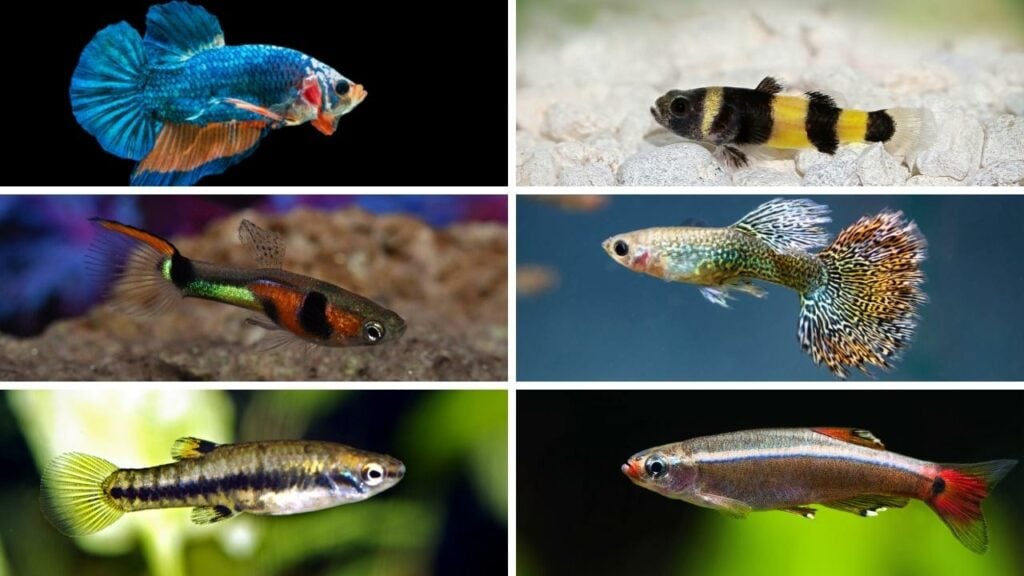
When you have a larger tank, it’s much easier to keep the water parameters in the ‘safe zone’ for your fish, good water quality is essential for your fish’s health.
I recommend that you consider upgrading to a minimum tank size of 5 gallons, preferably 10 gallons if you don’t want to be cleaning and performing water changes constantly.
But if it’s too late and you’ve already purchased a 3 gallon fish aquarium, I’ll go over the best choices of fish that you can keep.
At the end of this post, I’ll go over how to set up and maintain your tank, so you can keep your fish healthy.
- 10 Best Fish For 3 Gallon Tank
- How To Maintain A 3 Gallon Tank
- Fish To Avoid In A 3 Gallon Tank
- FAQ
- Closing Thoughts On The Best Fish For 3 Gallon Tanks…
10 Best Fish For 3 Gallon Tank
I’ve carefully selected what fish can live in a 3 gallon tank, but the choice is limited as this size tank is too small for most fish.
In my experience, the best fish for a 3 gallon aquarium is one of the following options:
- 1 Betta Fish
- 6-8 Cherry Shrimp
- 2-3 Endlers Livebearers
- 6 Ghost Shrimp
- 3 Least Killifish
1. Betta Fish
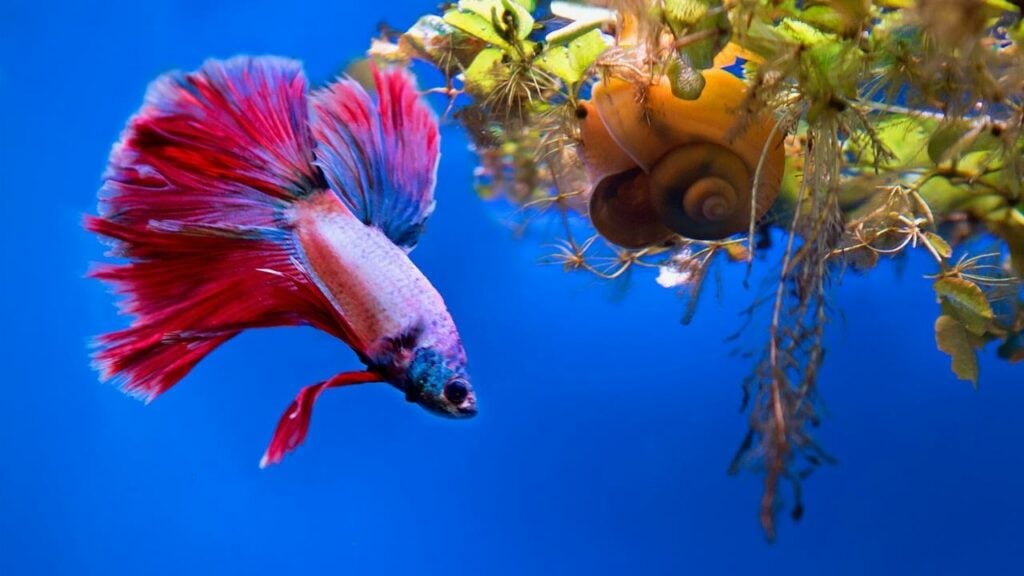
- Name / Scientific Name: Betta Fish / Betta splendens
- Care Level: Easy
- Temperament: Semi-aggressive
- Maximum Size: 3 inches
- Minimum Tank Size: 5 gallons
- Diet: Carnivore
- Water Temperature: 78°-82° F
- dKH: 5-20
- pH: 6.5-7.5
Also known by the name, Siamese fighting fish, betta fish are eye-catching with their long flowing colorful fins. They are available in a wide array of colors and patterns, so you’re sure to find one you love.
They are a great fish for beginners and I have done a detailed betta care guide if you want to see if they are the right fish for you.
Betta fish are aggressive and males will fight with each other to the death! So only keep 1 single betta in a tank.
Although there are a lot of photos online of betta fish being kept in vases, jars, or small bowls, it is practically impossible to keep the water parameters safe and healthy for your fish in such small containers.
If your betta fish appears lethargic, it can be a sign that the tank water is too cold. Ideally, your water temperature should be around 78° F. If you can’t maintain a constant temperature, use a heater.
Make sure your filter is on a gentle setting as bettas don’t like a high water flow.
Bettas like having places to hide but make sure any decorations you add to your tank don’t have any sharp edges that your betta can rip their fins on or bump into causing an injury such as popeye.
They also like silk or live plants with large leaves, you’ll often find your betta chilling out on the leaves. Avoid plastic plants as they can tear their fins up.
Betta fish are not picky eaters and will eat most things.
How Many Betta Fish In A 3 Gallon Tank?
Keep only 1 betta fish in a 3 gallon tank, you could try adding a few cherry shrimp or a nerite snail, but the betta may attack or eat them.
Some bettas are chilled out and some are menaces, it’s pot luck whether they will tolerate anything else in their tank.
Avoid adding ghost shrimp as they may nip at your bettas’ fins.
2. Bumblebee Goby
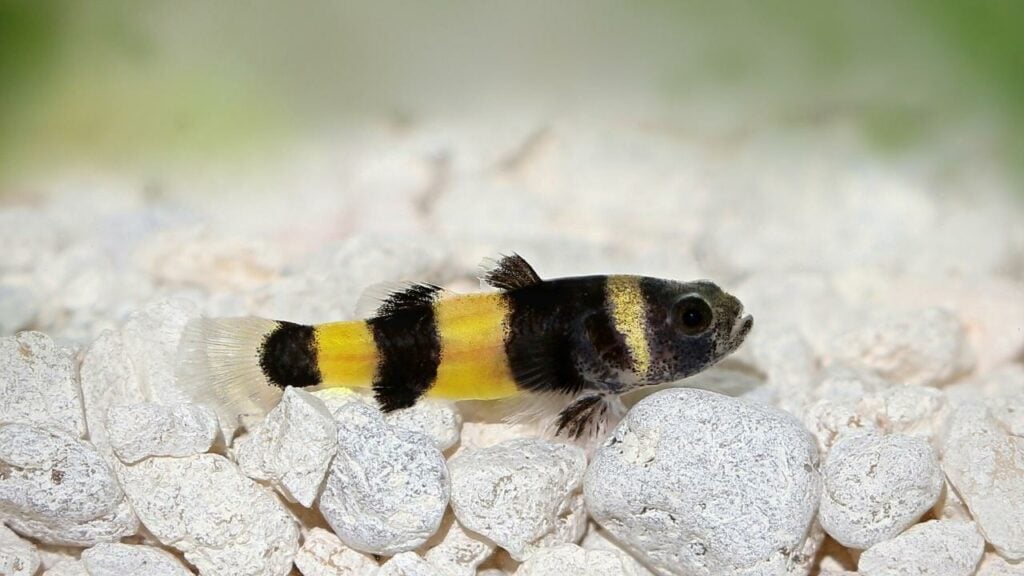
- Name / Scientific Name: Bumblebee Goby / Brachygobius doriae
- Care Level: Intermediate
- Temperament: Peaceful
- Maximum Size: 1.5 inches
- Minimum Tank Size: 10 gallons
- Diet: Carnivore
- Water Temperature: 74°-82° F
- dKH: 9-19
- pH: 7.5-8.2
With its black and yellow striped body, it’s fairly obvious how it got its name of bumblebee goby. Males have much brighter yellow stripes than females, so they are easy to tell apart.
I don’t recommend these fish for beginners.
They prefer brackish water (slightly salty) so it’s important to find out what level of salinity they were bred in, so you can match that with your aquarium at home.
Although these fish are small they are full of personality and like to claim and guard their own area of the tank. Males will scuffle if they invade each other’s space.
They prefer a sandy substrate and like to hide amongst rocks.
They prefer to be kept in groups of 5-7, but you would need a 10-gallon tank to keep this many bumblebee gobies.
They are notoriously picky eaters, it can be trial and error to find what these fish will eat.
Being carnivores they like good quality meaty foods, bloodworms, brine shrimp and daphnia are some good options to try.
How Many Bumblebee Gobies In A 3 Gallon Tank?
Keep 2 bumblebee gobies in a 3 gallon tank, they don’t like to be kept on their own.
However, they much prefer to be in a larger group of 5-7 and it’s best to choose this fish if you have a 10 gallon tank or larger.
3. Cherry Shrimp
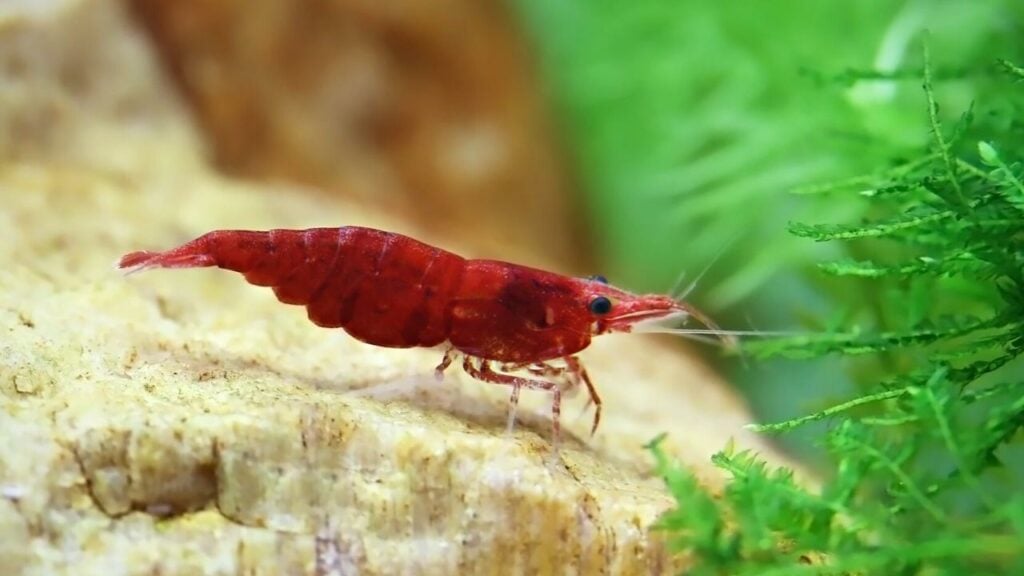
- Name / Scientific Name: Cherry Shrimp / neocaridina davidi
- Care Level: Easy
- Temperament: Peaceful
- Maximum Size: 1.5 inches
- Minimum Tank Size: 5 gallons
- Diet: Omnivore
- Water Temperature: 65°-80° F
- dKH: 3-8
- dGH: 6-15
- pH: 6.5-8.0
- TDS: 180-250
Despite their name, cherry shrimp come in a wide range of colors including red, yellow, and blue.
They’re able to adapt to a wide range of water parameters and are very peaceful, making them easy to care for.
They like to be kept in groups, so I recommend at least 5 of them.
Cherry Shrimp are easy to breed, as long as you have stable water parameters, males are smaller and less colorful than females.
Cherry Shrimp do a great job of eating your tanks’ algae, but you’ll also need to supplement their diet with high-quality shrimp food, blanched veggies, or sinking fish pellets.
How Many Cherry Shrimp In A 3 Gallon Tank?
Keep 6-8 cherry shrimp in a 3 gallon tank, they can be kept on their own or with most fish on this list.
Betta fish may eat or harass them.
4. Endler’s Livebearer

- Name / Scientific Name: Endlers Livebearer / Poecilia sp.
- Care Level: Easy
- Temperament: Peaceful
- Maximum Size: 1 inch
- Minimum Tank Size: 5 gallons
- Diet: Omnivore
- Water Temperature: 68°-82° F
- dKH: 1-12
- pH: 5.5-8.0
Endler’s livebearers are available in a variety of vibrant colors. Males are much more colorful than females.
If you’re wanting a small, colorful, hardy, easy to keep fish for beginners or children, these are ideal as they can adapt to a wide range of water parameters and are suitable for nano tanks.
These fish breed easily and are livebearers, meaning they give birth to live young. I recommend you keep a male-only tank to prevent this from happening, as a 3 gallon tank will not cope with the increased bioload from the baby fish.
If you would like to breed endlers, keep 1 male per 3 females and upgrade your tank to 10 gallons.
They are not picky eaters and will eat most flake, pellet foods, and frozen foods, and enjoy baby brine shrimp as a tasty treat.
How Many Endlers Livebearers In A 3 Gallon Tank?
Keep 2-3 Endlers in a 3 gallon tank.
You could keep a few cherry shrimp in with your Endlers.
5. Ghost Shrimp
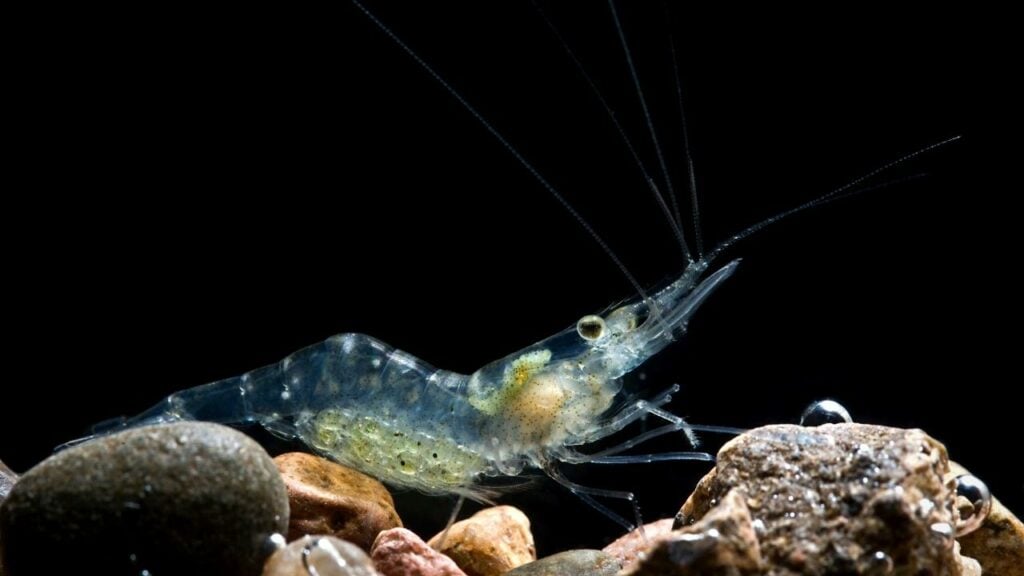
- Name / Scientific Name: Ghost Shrimp / Paleomonetes sp.
- Care Level: Easy
- Temperament: Peaceful
- Maximum Size: 2 inches
- Minimum Tank Size: 5 gallons
- Diet: Omnivore
- Water Temperature: 65°-80° F
- dKH: 1-7
- pH: 6.5-8.0
- dGH: 6-15
- TDS: 100-400
Also known as the glass shrimp, the ghost shrimp is transparent and really fascinating to look at, especially when the female is carrying eggs.
Ghost shrimp are often bred as cheap food for your fish so they are not always bred in the highest quality of conditions as they are not intended to survive for long!
If you are buying ghost shrimp to survive, it’s best to get them from a reputable breeder.
Ghost shrimp can adapt to a wide range of water parameters, as long as they remain stable.
Not as good at eating algae as cherry shrimps, they will spend most of their time searching the tank’s substrate for any leftover food. You can also feed them high-quality shrimp food, algae wafers, and bloodworms.
The ghost shrimp is a bit more aggressive than the cherry shrimp. They may fin nip slower swimming long-finned fish like bettas.
How Many Ghost Shrimp In A 3 Gallon Tank?
Keep 6 ghost shrimp in a 3 gallon tank.
Do not keep with betta fish as they may nip at their long flowing fins.
6. Guppies

- Name / Scientific Name:Guppy Fish / Poecilia reticulata
- Care Level: Easy
- Temperament: Peaceful
- Maximum Size: 2 inches
- Minimum Tank Size: 5 gallons
- Diet: Omnivore
- Water Temperature: 72°-80° F
- dKH: 8-12
- pH: 7.0-8.2
Guppy fish are available in a huge choice of vibrant eye-catching colors and patterns, males are more colorful than females.
Guppies are beginner-friendly fish, reasonably hardy, and readily available in most fish stores as they are one of the most popular freshwater fish.
I have done a much more in-depth guppy care guide if you want to see if they are the right fish for you.
Although I have included them on this list, they prefer to be kept in groups of at least 5, but you’d need a larger 10-gallon tank for that many guppies.
One important thing to note is that guppies are livebearers (they give birth to live fish) and breed like crazy…another reason you need to upgrade your tank to help deal with the increased bioload!
If you would like to breed guppies, keep 1 male per 3 females and upgrade to a 10 gallon tank.
They are a good choice of fish if you live in a hard water area.
They are not picky eaters and will eat most flake, pellet foods, and frozen foods, and enjoy baby brine shrimp as a tasty treat.
How Many Guppies In A 3 Gallon Tank?
Keep 1-2 male or 1-2 female guppies in a 3 gallon tank, if you have one of each sex, you’re going to have baby guppies in no time!
You could also add a few shrimp and/or a nerite snail.
7. Least Killifish

- Name / Scientific Name: Least Killifish / Heterandria formosa
- Care Level: Easy
- Temperament: Peaceful
- Maximum Size: 1.25 inches
- Minimum Tank Size: 3 gallons
- Diet: Omnivore
- Water Temperature: 70°-80° F
- dKH: 5-20
- pH: 7.0-8.0
The least killifish are not the most colorful fish available, they have a silvery brown body with a black horizontal stripe…but don’t let that put you off, they are a great choice for a 3 gal tank.
Males are smaller than females and the females have a black spot on their dorsal and anal fins, so you can tell them apart.
Least killifish are a great option for nano tanks or small fish tanks due to their small size and are a good choice for beginners.
These fish breed easily and are livebearers, meaning they give birth to live young. I recommend you keep a male-only or female-only tank to prevent this from happening.
If you would like to breed these fish, keep 1 male per 3 females and upgrade to a 5 gallon tank, so that your tank can cope with the increased bioload from the babies.
They will eat most foods, flakes, micro pellets, bloodworms, and baby brine shrimp. They will also nibble at any algae in your tank.
Make sure you crumble the flakes or chop up bloodworms or shrimp as these fish have tiny mouths.
How Many Least Killifish In A 3 Gallon Tank?
Keep 3 same-sex least killifish in a 3 gallon tank.
You can keep a few cherry shrimp in with them, but the killifish will eat any baby shrimp.
8. Nerite Snail
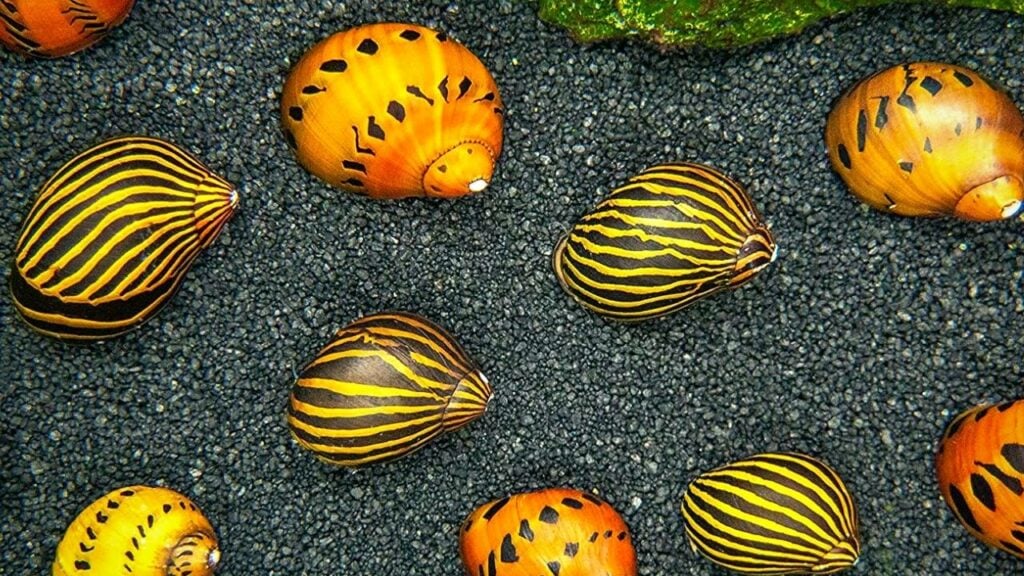
- Name / Scientific Name: Nerite Snail / Nerita sp.
- Care Level: Easy
- Temperament: Peaceful
- Maximum Size: 1 inch
- Minimum Tank Size: 5 gallons
- Diet: Herbivore
- Water Temperature: 72°-78° F
- dKH: 5-12
- pH: 7.5-8.5
Nerite snails come in a huge range of colors and shell patterns, my favorite is the Zebra Nerite Snail, with its striking gold and black striped pattern.
They are peaceful and safe to keep with fish and invertebrates and won’t eat your plants.
Nerite snails are great at eating algae, but they will need their diet supplementing once the algae is gone and they particularly like algae wafers or blanched vegetables like zucchini, kale, or cucumber.
Nerite snails require brackish or saltwater to reproduce, so you don’t have to worry about getting overrun with baby snails, like with some other snail species.
Female nerite snails will lay tiny oval-shaped white egg capsules on most surfaces in your tank, but they won’t hatch/survive in a freshwater tank. You can scrape/clean these off if you see any.
How Many Nerite Snails In A 3 Gallon Tank?
Keep 1 nerite snail in a 3-gallon tank.
You can keep them with the fish and shrimp listed. Betta fish may harass your snail.
9. Pea Puffer
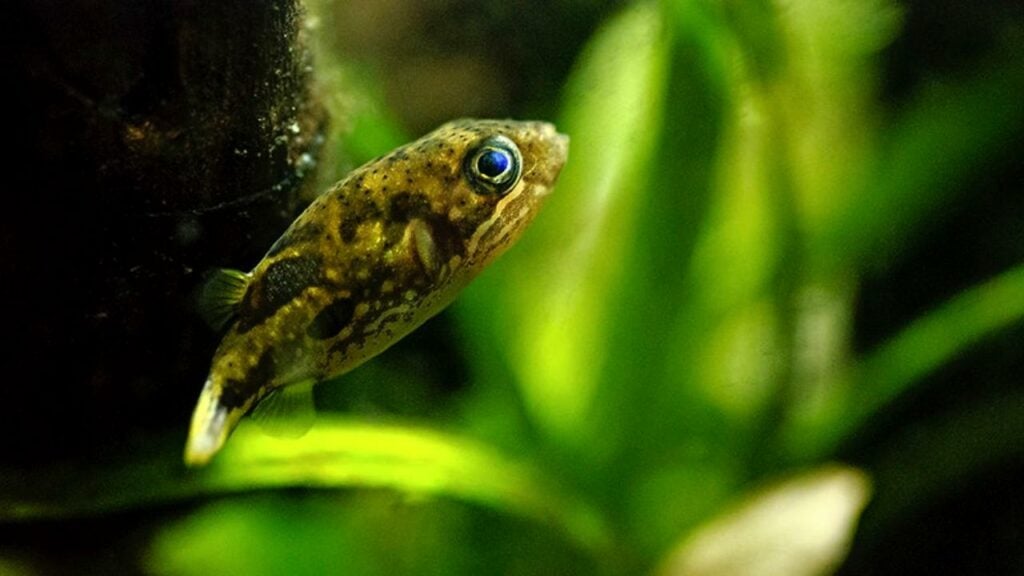
- Name / Scientific Name: Pea Puffer / Carinotetradon travancoricus
- Care Level: Moderate
- Temperament: Semi-aggressive
- Maximum Size: 1.25 inches
- Minimum Tank Size: 5 gallons
- Diet: Carnivore
- Water Temperature: 74°-82° F
- dKH: 5-15
- pH: 6.5-8.0
Pea puffers, also known as dwarf puffers or pygmy puffers.
They are super cute small freshwater puffer fish with googly eyes that work independently.
They have golden yellow bodies with black splodges. Females are plumper and paler than males and males have a dark line on their belly once they mature.
Although they are small and cute they can be feisty and will chase and nip other fish, so I don’t recommend them for a community aquarium.
They prefer a heavily planted tank with plenty of hiding places, a sandy substrate, and a low water flow.
Pea puffers don’t tend to eat prepared flakes or pellets, they prefer live or frozen baby brine shrimp, daphnia, and bloodworms. They will also eat baby ramshorn snails.
How Many Pea Puffers In A 3 Gallon Tank?
Keep 1 pea puffer on its own in a 3 gallon tank.
10. White Cloud Mountain Minnow

- Name / Scientific Name: White Cloud Mountain Minnow / Tanichthys albonubes
- Care Level: Easy
- Temperament: Peaceful
- Maximum Size: 1.5 inches
- Minimum Tank Size: 5 gallons
- Diet: Omnivore
- Water Temperature: 65°-75° F
- dKH: 10-15
- pH: 6.5-8.0
White cloud mountain minnows have a lovely shimmering bronze colored body with a white stripe that goes from eye to tail and a bright splash of red on their dorsal and tail fins.
They are a great choice for beginner fish keepers.
They prefer cooler water temperatures and may not need a heater if you live somewhere that’s warm year-round. If you can keep the tank water at a constant 72° F, they will be happy.
They do prefer to be kept in larger groups of at least 6, but you’d need a 10 gallon tank for this many fish.
They will eat most foods, flakes, micro pellets, bloodworms, and baby brine shrimp.
How Many White Cloud Mountain Minnows In A 3 Gallon Tank?
Keep 2 white cloud mountain minnows in a 3 gallon tank.
However, I recommend you upgrade to a 10 gallon tank if you want to keep this fish, as they prefer to be kept in groups of at least 6.
How To Maintain A 3 Gallon Tank
Setting up a 3-gallon aquarium is just like any other size tank:
- Add the substrate
- Add any decor items and plants
- Fill the tank with water and add a water conditioner
- Setup the sponge filter and air pump
- Fit the heater
- Cycle the tank
Important: You must cycle your fish tank before adding any fish or risk your fish dying from ammonia poisoning.
Maintaining the nitrogen cycle and clean water is where it gets tricky with a 3 gallon tank.
I aim to keep my nitrate levels below 20ppm, but with such a small volume of water, this could mean you’re going to be very busy with water changes.
When performing water changes, you should aim to change approximately 25% of the water at a time, don’t forget to condition the water before adding it to your tank.
Check and record your water parameters daily so you can see how quickly your tank takes to build nitrate levels up to the point you have to perform water changes.
You’ll soon figure out how often you need to perform a water change to keep nitrates at safe levels for your fish.
The API Freshwater Master Test Kit has been my go-to water testing kit for years, or you could use API 5-in-1 test strips which are quicker and easier to use, but not as accurate.
Clean the filter when it looks gunked up or if your water flow appears reduced.
Put the filter media and some tank water in a plastic ziplock bag and give the media a thorough squeezing out to get all the detritus out of it. You may need to repeat this process a few times.
Do not use tap water to clean your filter media.
Tap water contains chlorine/chloramine which can kill off the beneficial bacteria you colonized when cycling your tank.
Use the dirty tank water to water any plants you have in your home/garden, you cannot buy a better fertilizer than this!
I’ve done a much more in-depth guide on how to clean your fish tank.
Fish To Avoid In A 3 Gallon Tank
The following types of fish should be avoided in a 3 gallon aquarium.
Schooling or Social Fish
Some fish prefer to be in large groups of their own species.
These fish are not suitable for a 3 gallon tank, as it is too small to house so many fish, and they don’t enjoy being kept on their own.
Some popular schooling or social fish to avoid keeping in a 3-gallon tank are:
- Otocinclus Catfish
- Tetras
- Zebra Danios
Large Bodied Fish
Obviously, any large bodied fish should be avoided.
Anything that is going to grow over 2-3 inches in length when fully grown will be too big for a 3 gallon fish tank.
FAQ
Is A 3-Gallon Tank Big Enough For A Goldfish?
No, a 3 gallon tank is not big enough for a goldfish.
It’s a common misconception that goldfish can be kept in small tanks.
Depending on the variety of goldfish, you will need a minimum of 20 gallons right up to 100 gallons for the larger varieties.
Is A 3 Gallon Tank Good For A Betta?
A 3-gallon tank is suitable for a betta fish, but the smallest tank I recommend is 5 gallons.
This is because it’s hard to keep the water clean and toxins at a safe level for fish in smaller volumes of water.
Is 3 Gallon Tank Too Small?
This is a very controversial question and you’ll see on forums and Facebook groups that people have very strong opinions on this!!
If you choose a suitable fish and you are prepared to put in a lot of work to keep the water safe for your fish, you can make a 3-gallon tank work.
The reason I don’t recommend 3-gallon aquariums is that it is so difficult to keep the toxins at safe levels, especially for beginners and it ends up being a chore having to perform water changes all the time.
The fish ends up suffering and dying within a month and people give up on this great hobby.
Best Size Fish Tank For Beginners?
It’s a misconception that smaller tanks are easier to keep, the problem is because there is such a low volume of water, it can deteriorate quickly and leave your fish belly up in no time.
I would say the best tank size for beginners is 10 gallons or larger, as it’s easier to keep the water safe and your fish healthy.
Closing Thoughts On The Best Fish For 3 Gallon Tanks…
Now you know the best fish for a 3 gallon tank, and how to keep such a small volume of water safe and clean for your fishy friends.
Just to recap, the best choice of fish for a 3-gallon tank is one of the following options:
- 1 Betta Fish
- 6-8 Cherry Shrimp
- 2-3 Endlers Livebearers
- 6 Ghost Shrimp
- 3 Least Killifish
I’ve got plenty of guides on keeping your aquarium in tip-top shape in the aquarium health section.
